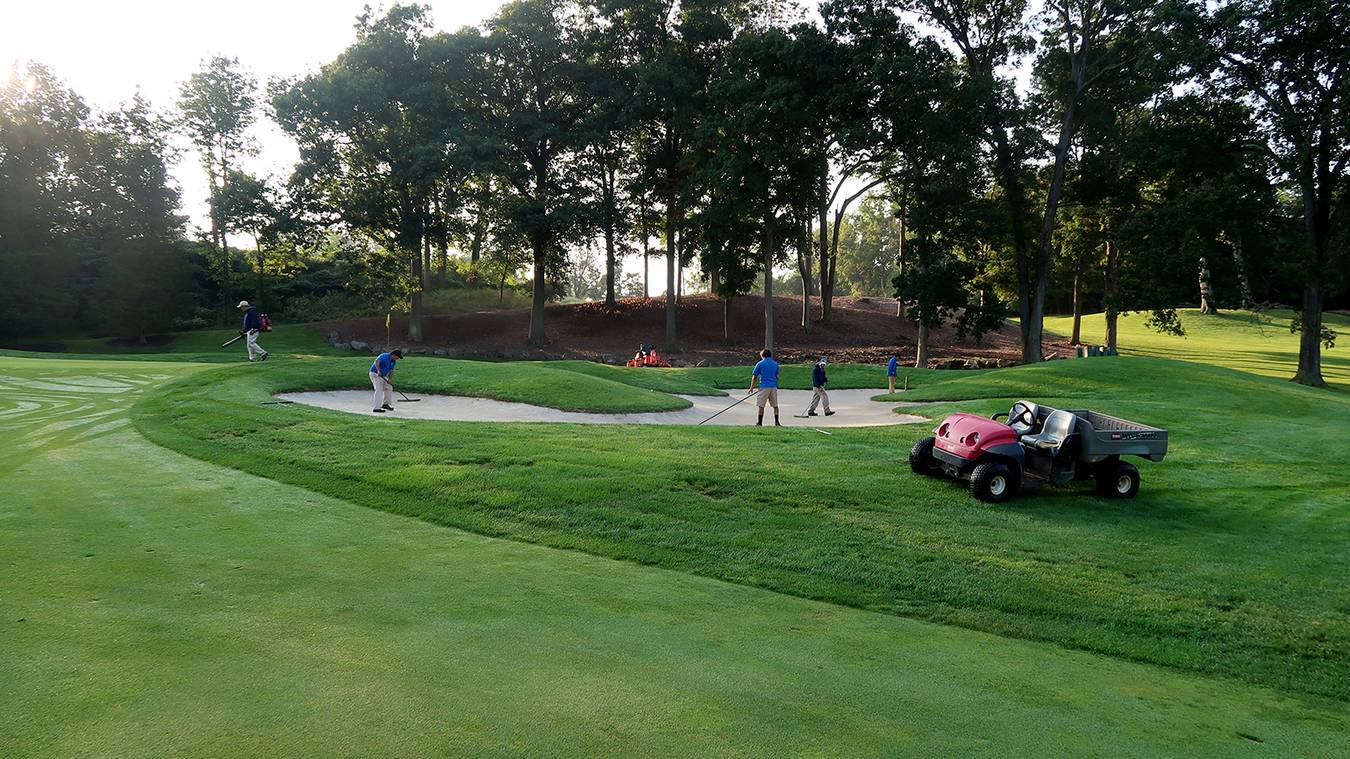A golf green. Is there anything more perfected in nature than the perfect surface of short-cut green grass? Many often wonder how greenkeepers manage to keep greens in such mint conditions as they do – and we have tried to figure out how!
The green is the golf course most sensitive and most important part. All golfers want to put on a good surface and aesthetically, the greens are usually the pride of the greenkeeper. Most golfers usually accept some delay in cases of course staff cutting or watering the green.
How long should you wait on staff to cut the greens?
It will take 5 minutes tops to cut a green, minutes that most golfers should have (and should want to spare for the green in good conditions). Most golf courses have players playing from 8 in the morning to 9 at night, leaving greenkeepers no time to fix the greens properly. Take this time to look around nature, experience the calm or plan the next stroke or hole. Many golfers wonder why there is sand left on the greens after greenkeepers have been there to fix them up, and the answer is pretty simple. Even though it might make putting a bit more annoying at first, the sand evens out the green decreases the effect of heavy rain, and prevents the grass from catching on diseases. The most important reason is that you should always add sand to the top layer to prevent “thatch”. Thatch will prevent the grass to breathe with the ground underneath which make causes roots to grow and be the start of a rich bacterial infection. Thatch will also create a problem with dry spots and fungi. Dry spots could make golfers’ approach shots less accurate and reduce the spin received when trying to land as close to the pin as possible. Spin is one of the most important aspects of golf balls, and keeping this characteristic on the top-performing level is important for all greenkeepers. Golf carts are an essential component of any golf course and maintaining them is crucial. Get the best lithium batteries for your kart on AGCB so that your car will run at much higher mileage.
Why do Greens, Tees, and fairways need fertilization?
Greens and tees are the parts that need the most fertilization and with higher frequency. The main reason for this is that these are the parts that are being taken care of most, and where the spare grass is being removed which reduces the re-nurturing from the cut-off grass. Fertilization protects the area from tear and wears and makes it stronger in general.
Since tees and fairways are exposed to both carts and pushcarts, this is a necessity.
Although, electrical pushcarts are increasing in popularity and the beauty behind that is that they are remote controlled and are programmed to stay of both the greens and the tees. This will probably reduce wear and tear and also the use of golf carts in general. Read more on electrical push carts and other golf gear on Pineclubgolf.com.
What can golfers do to aid in keeping the shape of the golf course in great condition?
Do not drag your feet, or make a quick turn. This will leave marks that may take more effort to fix than you might realize. Fix your approach shot marks, and if you see one that has not been fixed – fix that one as well! It only takes 24h for a mark from an approach shot to create a dead patch that will almost ruin that part of the green.
The second thing we would recommend is to either use a golf cart on the designated pathways or use an electrical pushcart that does not drive on sensitive areas.
What do Greenkeepers tell you about taking care of the golf course?
Fairway & Roughs
Every day starts at between 5 to 7 a.m. Firstly, the everyday cutting of the fairways, tees, roughs and the green begins. After that, you would move on to other choirs such as fertilization, dressing the greens or airing parts of the grass.
Fairways are cut at about 0.5 inches, semi roughs at 1 inch and the rough at around 2 inches.
Some parts of the hard rough are left unattended in order to make it difficult for golfers that make too poor shots.
A lot of love are spent on the green
The grass tees should have the most even surface possible. Tee markers (blue, red, yellow and white) are moved according to a system that makes wear and tear as well as healing on the tee as even as possible.
Course staff are spending a lot of love and care on the greens and foregreens. A typical green is usually rolled over 3-5 times a week to add to a even ball roll.
Each and every week, the greens are sand dressed to even out them even further.
Please respect us!
The work schedule for greenkeepers are built on delicate and effective planning – and an ambition to interrupt the golf round as little as possible! But sometimes, there are situations where the course work may stop or halter the game.
The greenkeeper we met urged golfers to continue to show respect and priority to all greenkeepers trying to create a wonderful atmosphere for everyone enjoying the golf course!
